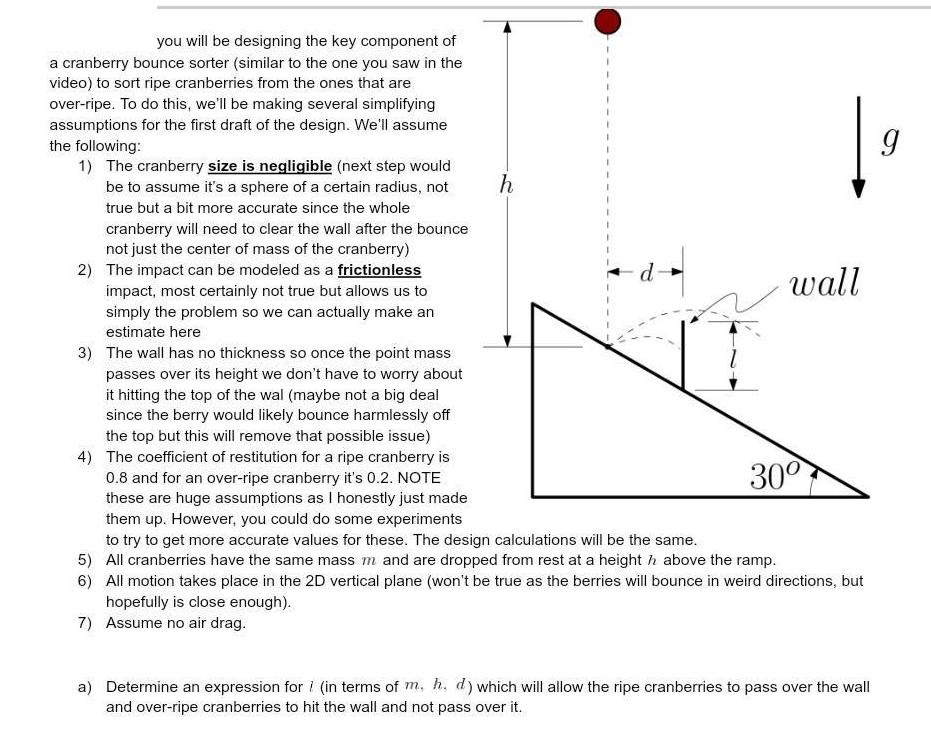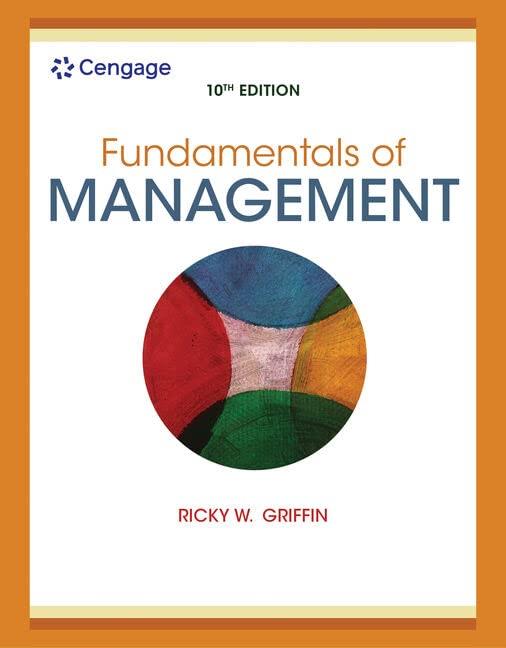Answered step by step
Verified Expert Solution
Question
1 Approved Answer
you will be designing the key component of a cranberry bounce sorter (similar to the one you saw in the video) to sort ripe


you will be designing the key component of a cranberry bounce sorter (similar to the one you saw in the video) to sort ripe cranberries from the ones that are over-ripe. To do this, we'll be making several simplifying assumptions for the first draft of the design. We'll assume the following: 1) The cranberry size is negligible (next step would be to assume it's a sphere of a certain radius, not true but a bit more accurate since the whole cranberry will need to clear the wall after the bounce not just the center of mass of the cranberry) 2) The impact can be modeled as a frictionless impact, most certainly not true but allows us to simply the problem so we can actually make an estimate here h d wall 3) The wall has no thickness so once the point mass passes over its height we don't have to worry about it hitting the top of the wal (maybe not a big deal since the berry would likely bounce harmlessly off the top but this will remove that possible issue) 4) The coefficient of restitution for a ripe cranberry is 0.8 and for an over-ripe cranberry it's 0.2. NOTE these are huge assumptions as I honestly just made them up. However, you could do some experiments to try to get more accurate values for these. The design calculations will be the same. 5) All cranberries have the same mass m and are dropped from rest at a height above the ramp. 6) All motion takes place in the 2D vertical plane (won't be true as the berries will bounce in weird directions, but hopefully is close enough). 7) Assume no air drag. 30 a) Determine an expression for (in terms of m. h. d) which will allow the ripe cranberries to pass over the wall and over-ripe cranberries to hit the wall and not pass over it. g -right before the berry impacts the ramp, determine the velocity components along and perpendicular to the ramp surface -Use what you know about frictionless impacts with an immovable object(ramp) to determine the post impact velocity component perpendicular to the ramp surface. -What do you know about the velocity component along the ramp surface from before and after the impact? -Once you know the post impact velocity (magnitude and direction OR vector expression of it), projectile motion might apply to the motion of the cranberry after impact. -How tall can the wall be and still have the ripe ones clear it? -How low can the wall be and still have the over-ripe ones hit it? you will be designing the key component of a cranberry bounce sorter (similar to the one you saw in the video) to sort ripe cranberries from the ones that are over-ripe. To do this, we'll be making several simplifying assumptions for the first draft of the design. We'll assume the following: 1) The cranberry size is negligible (next step would be to assume it's a sphere of a certain radius, not true but a bit more accurate since the whole cranberry will need to clear the wall after the bounce not just the center of mass of the cranberry) 2) The impact can be modeled as a frictionless impact, most certainly not true but allows us to simply the problem so we can actually make an estimate here h d wall 3) The wall has no thickness so once the point mass passes over its height we don't have to worry about it hitting the top of the wal (maybe not a big deal since the berry would likely bounce harmlessly off the top but this will remove that possible issue) 4) The coefficient of restitution for a ripe cranberry is 0.8 and for an over-ripe cranberry it's 0.2. NOTE these are huge assumptions as I honestly just made them up. However, you could do some experiments to try to get more accurate values for these. The design calculations will be the same. 5) All cranberries have the same mass m and are dropped from rest at a height above the ramp. 6) All motion takes place in the 2D vertical plane (won't be true as the berries will bounce in weird directions, but hopefully is close enough). 7) Assume no air drag. 30 a) Determine an expression for (in terms of m. h. d) which will allow the ripe cranberries to pass over the wall and over-ripe cranberries to hit the wall and not pass over it. g -right before the berry impacts the ramp, determine the velocity components along and perpendicular to the ramp surface -Use what you know about frictionless impacts with an immovable object(ramp) to determine the post impact velocity component perpendicular to the ramp surface. -What do you know about the velocity component along the ramp surface from before and after the impact? -Once you know the post impact velocity (magnitude and direction OR vector expression of it), projectile motion might apply to the motion of the cranberry after impact. -How tall can the wall be and still have the ripe ones clear it? -How low can the wall be and still have the over-ripe ones hit it?
Step by Step Solution
★★★★★
3.43 Rating (162 Votes )
There are 3 Steps involved in it
Step: 1
To determine an expression for the height h in terms of m h and d which will allow ripe cranberries to pass over the wall and overripe cranberries to ...
Get Instant Access to Expert-Tailored Solutions
See step-by-step solutions with expert insights and AI powered tools for academic success
Step: 2

Step: 3

Ace Your Homework with AI
Get the answers you need in no time with our AI-driven, step-by-step assistance
Get Started


